AIDS Council Seeks Best Current Assessments and Future Forms of Outreach
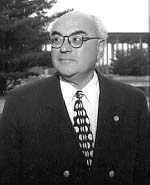
“The search to provide the fullest range of services possible on campus in the area of HIV and AIDS-prevention is about nothing less than keeping students alive” said James P. Doellefeld, Vice President for Student Affairs.
And that is the charge given to the Vice President’s Advisory Council on AIDS Prevention, which met for the first time on Sept. 24 and which will, through the various foci of its task forces, continually advice Doellefeld on the viability of future prevention, education and testing programs for students.
“The University has charged the committee with a most urgent mission: determining effective strategies for preventing the spread of HIV infection across our campus,” said Dr. David Carpenter, dean of the School of Public Health, and chairman of the Advisory Council.
“As chair, I am encouraging the committee to take an aggressive approach to the issue of HIV infection among University students. I expect that we will propose a set of recommendations that will educate students to the need for prevention, testing, and time treatment for this deadly disease.”
The Council will meet about four times per year, but in addition there will be task forces within the group that will meet more often, these chaired by University Health Education Carol Stenger.
“For a first meeting, I was extremely impressed with the steps we took,” said Stenger. She said that three groups were formed, to: 1) find out to assess the current health behavior of University students; 2) explore what kinds of educational activities can prove effective, and look at what additional grant funding might be available for that purpose; and 3) find methods outreach to those students that do not normally respond to health messages and warnings.
“Before we expand our educational services even further, we certainly want to do an assessment of where we are now in terms of behavior and affective outreach,” she said. “That is why the Council’s make-up of faculty, staff and students is the right mix, particularly in that there are experienced researchers included who will certainly help in making our surveys accurate.”
Vinny Reda
University Sets Personal Records at American Heart Walk

With President Karen Hitchcock as NE Region 1997 chairperson, the American Heart Walk, held on Sept. 27 at Siena College, set records for the region and University at Albany participation. About 350 from the campus community participated, raising more than $8,500 — 150 and $2,300 above last year’s marks.
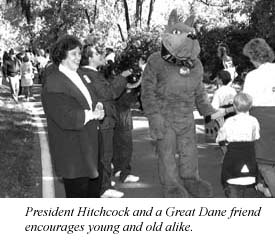
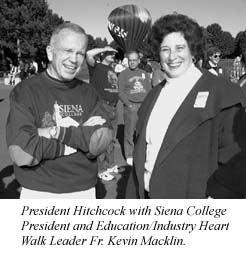
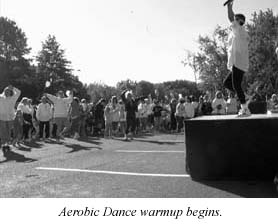
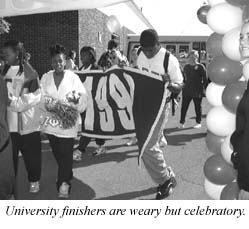
Lemon Award Winner Made Long Climb to Begin Brilliant Research Career
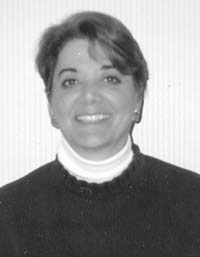 By Vinny Reda
By Vinny Reda
There looks to be a long road of success ahead for Dr. Betsy Kagey in her research in the field of environmental epidemiology. And if it’s longer than the one she took to become Dr. Betsy Kagey, that will be saying something.
“With a husband, two kids and a part-time job, getting my doctorate and putting my dissertation together was not the easiest point of my life,” she admits.
Not only did she get her Ph.D. in environmental health and toxicology from the University’s School of Public Health in 1995, but a few weeks ago she found that the dissertation that completed the degree was something extra special. It won her the semi-annual Paul C. Lemon Ecology Award from the Department of Biological Sciences, “for a thesis that is an outstanding contribution to our understanding of the ecological and environmental problems, inter-relationships and challenges in the natural world.”
Kagey’s study, “Indicators of Human Reproductive Health within the Great Lakes Drainage Basin Ecosystem,” was chosen over 460 other M.S., Ph.D. and D.A. theses culled from 1995 and 1996, of which nine were chosen as finalists. The five-member review committee consisted of University professors from departments of biological sciences (two), public administration and policy, atmospheric sciences, and geography and planning.
“I’m thrilled by the award; it is a real shot in the arm,” said Kagey, now an adjunct professor teaching environmental health in the Department of Geography at Frostburg State University in western Maryland. “I’ve been here in Maryland for four years now, so the award came out of the blue.”
Her thesis advisor, Alice Stark, points out that Kagey’s work has in fact traveled far beyond academia to make a lasting contribution in scientific knowledge and its efficient use by government.
“Betsy’s study was extremely interesting, not only for New York State, but for all the areas bordering all sides of the Great Lakes,” said Stark. “It was so comprehensive that not only were its outcomes used by the consortium of Great Lake governors of both the U.S. and Canada, but that consortium determined that it was not worth spending any more energy and money on ongoing projects that could not hope to better what she had done.”
Stark said that Kagey made use of large amounts of data in imaginative ways, “using existing databases on reproductive health not designed to answer geologic and geographic questions. She brought in 20 years of birth records and changed codes in order to get comparable codings. She applied her data to the river basins, not just the lakes, which gave a perspective never achieved before.
“She was not afraid to do the things that are not standard in order to accomplish something significant. I don’t think people realize what goes into a piece of work of this quality. That’s why I always say that term ‘all but dissertation’ is rather silly. The dissertation is more than half of the doctorate, if done correctly.”
Kagey received her masters in environmental epidemiology in 1974 from the University of North Carolina. “I wasn’t ready to move on to my doctorate just yet,” she said, “and wound up getting married.” Her husband, Richard, was a producer and advertiser in theater who went with Betsy to New York City in 1976 to learn of the Broadway theater market. From 1976-82, Betsy Kagey was an assistant professor at Downstate Medical Center in Brooklyn.
While there, she worked as co-investigator with a biologist and a geologist on a five-year Environmental Protection Agency study on the health effects associated with strip mining of midwestern coal in Missouri. “That’s when I got interested in the relationship between geology, environmental geochemistry and health,” she said.
In 1985, Kagey, her husband and newborn son moved to Glens Falls, where Richard set up an advertising agency, taught at Castleton State College, and organized a summer music Colony at Scroon Lake that still exists.
By then, she knew she wanted a full-time career too, as teacher and researcher. “I needed my doctorate to achieve that, but I had to have a job too.” By 1987 she had begun taking graduate courses at the School of Public Health while working as a mentor at Empire State College. In 1991-92 she started full-time study, leading to the completion of coursework and then her award-winning dissertation.
“One very important thing about the School of Public Health was the ability to access existing health Department birth certificate data which spanned 20 years,” she said. “That provided an historic perspective of maternal health within the Great Lakes drainage basic, a hydrogeologic area.
“What makes the Lemon Ecology award such a special honor is the interdisciplinary nature of the award committee. I know there were atmospheric scientists, biologists, geographers and public policy people on it, and to be recognized by all those different departments is really the best thing I could think of — because I believe strongly in the importance of an interdisciplinary approach in the study of the relationship between the environment and human health.”
Today, Kagey continues those efforts. Through a grant from the Pfizer Pharmaceutical corporation, she is studying the geographic distribution of cancer rates in the coal-mining region of western Maryland. She is also on the executive board of the Society for Environmental Geochemistry and Health.
Students and Swiny Make Excellent Team in Uncovering Ancient Cyprus
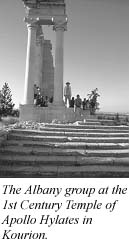 by John LeMay
by John LeMay
Eleven undergraduate and two graduate students from the University got to explore the archeology of ancient Cyprus first-hand over the summer, thanks to Stuart Swiny, director of the Institute of Cypriot Studies in the Department of Classics.
The group was searching for undiscovered sites and artifacts in a region adjacent to the early Bronze Age settlement of Sotira, near the southern coast of Cyprus. Over a six-week period, they surveyed an area of 13 square kilometers, walking hundreds of miles in hot weather. The terrain featured hills and gorges and was covered with olive trees, carob trees, pine and gorse.
The survey team worked five days a week and spent the sixth day touring the island in land rovers, visiting a total of six museums and 24 archaeological sites.
“On the seventh day,” as Swiny put it, “we retired to the beach.”
“It was physically and intellectually demanding,” Swiny said, “and the students rose to the occasion. I couldn’t have wanted a better team.” The students, none of whom had previous field experience, had to “gain skill in identifying and dating the pottery and flint artifacts which sometimes littered the ground — to become knowledgeable in the cultural assemblages of the island for all periods.
“We got good material,” said Swiny, who joined the Albany faculty in 1996, “I’ve been excavating Sotira for 15 years, and I wanted to get a better understanding of human exploitation of the region over an eight- or nine-thousand-year period.”
Using a laptop computer and Geographical Information System software purchased by the University, the survey team was able to overlay data from their field notes onto maps that had been electronically scanned by team member Tom Reynolds.
“The main contribution of the survey to Cypriot studies,” Swiny said, “was a discovery of about ten early Byzantine farmsteads” dating from the 7th and 8th Centuries A.D. The sites were found near the ancient city of Kourion, which was continuously occupied from around 1000 BC through the 8th Century AD.
Chris Mavromatis, an MA student in the classics department, said, “I would like to do my thesis on Byzantine Cyprus based on some of the material we recovered during the survey.” Of the trip as a whole, Mavromatis said, “The group got along well. We worked hard and definitely had a good time.”
Mavromatis added that the trip was valuable culturally as well as archaeologically, since the group stayed in a rural village and got to know the local people. A woman in the neighborhood where they stayed often invited team members for coffee and cake. “Every morning around 4:30, a husband and wife would pass by on their tractor, and an old man on the way to his fields on a donkey” said Mavromatis.
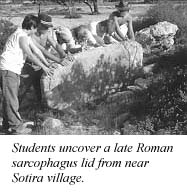 One of the team’s more dramatic finds was a late Roman sarcophagus lid
found near Sotira (photo). Sarah Kozyra, a senior majoring in anthropology,
said “That was a particularly good day. We’d split up and about seven of us
found a series of late Roman tombs — a nice little cluster, but they had
all been looted. There was this sarcophagus lid outside one of them. We
flipped it over and there was a raised line going down the center for
decoration. When you go out in the morning, you never know if you’re going
to find anything, and it’s exciting when you do.”
One of the team’s more dramatic finds was a late Roman sarcophagus lid
found near Sotira (photo). Sarah Kozyra, a senior majoring in anthropology,
said “That was a particularly good day. We’d split up and about seven of us
found a series of late Roman tombs — a nice little cluster, but they had
all been looted. There was this sarcophagus lid outside one of them. We
flipped it over and there was a raised line going down the center for
decoration. When you go out in the morning, you never know if you’re going
to find anything, and it’s exciting when you do.”
Kozyra said she “would absolutely love to go back.”
Another team member, an environmental studies major at Barnard College and the only non-Albany student, was responsible for a sub-project; she conducted a study within the survey area of plant life, erosion and other indicators of human impact on the environment. Her purpose was to establish a record of current environmental conditions for future comparison.
Not all of the Albany team members were students in fields related to antiquities. Daniel Holdren, a computer science major, said he went on the trip because “it sounded interesting,” and said he wasn’t disappointed. Holdren said he learned a lot and found the environment drier and “generally more pleasant” than here. Holdren stated that after his experience in Cyprus, he thought he could explain the survey sites to a newcomer. “But not as well as Stuart,” he added.
The students paid a small overhead plus plane fare to join the survey. They attended preparatory lectures in Albany and a symposium in Cyprus. Mavromatis, the M.A. student, said “We got to visit all the sites we had studied in class.”
Swiny said of his future plans, “I’d like to start digging again in the summer of 1999 at the early Bronze Age site in Sotira with a team of students from Albany. Several of the students on this trip said they’d very much like to return.”
Chamber Singers Take Renaissance Christmas Feast to Troy
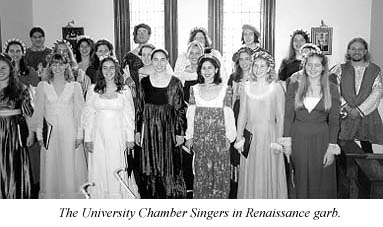
Like a roving band of carolers spreading goodwill, the University Chamber
Singers move their holiday feast to Troy this year, when the Renaissance
Christmas Madrigal Dinners take residence at the Hudson Valley Community
College Cultural Center the evenings of Dec. 5 and 6.
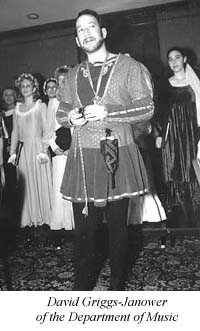
“It’s a really wonderful venue — spacious and atmospheric,” said David Griggs-Janower of the Department of Music, who conducts and serves as chief “Lord of the Manor” for this repast from the past. “And it’s also a chance to work with a fellow SUNY institution.”
In fact, Hudson Valley’s president, Stephen Curtis, is himself a part-time choral director. “Knowing what a splendid site the Cultural Center would be for the dinner, I asked him if it would be possible for us to hold it there, and he was just thrilled by the idea,” said Griggs-Janower.
Singers dressed in Renaissance garb will lead a procession through the decorated hall, the hoisting of the toast from the wassail bowl, the bearing of the boar’s head, all the while singing and leading carols. During the main meal, catered by Angelo Mazzone of the Glen Sanders Mansion restaurant, minstrels will serenade individual tables, while other “Choyre” singers dance, juggle and jest. The figgy pudding and a concert by the Lords and Ladies concludes the evening.
Doors open at 6:15 p.m. at the Center, located on Vandenburgh Avenue, with ceremonies beginning promptly at 7 p.m. Reservations are by mail only, with tickets $35 each ($12 tax deductible as a contribution to the Chamber Singers) and checks made out to University at Albany Foundation, and mailed to D. Janower, PAC-Music, University at Albany, Albany, NY 12222. For information, call 442-3997.
Vinny Reda
